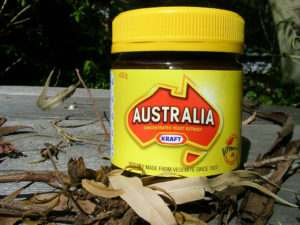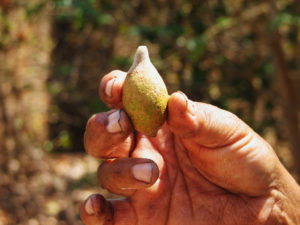This Australia Day we explored some of the things that make Australia home: kangaroos, Vegemite, and more.

Two joeys playing. We wonder if they know it’s Australia Day and not Boxing Day. Image: Scott Calleja/Flickr.
This Australia Day we’ve pulled together some great stories and facts that will have you leading the conversation over the sizzles of the Bee-Bee-Que. The parlous journey of kangaroo joeys, the origin of Vegemite, bush food delights, and pesky bush flies — this is the place to discover more about our national icons!
G’day, Skip
Fast facts
- Our sunburnt country is home to over 35 million kangaroos, probably millions more – they’re hard to count!
- Kangaroos can cover 7 metres in a single hop and can reach speeds of over 50 kilometres an hour (faster than my gran drives!).
- And finally, to avoid any BBQ arguments, the University of Tasmania and collaborators are happy to let you know that most kangaroos are in fact left handed (the real south paws?).
Ask anyone from overseas to name one thing they know about Australia, and the answer will be that unique bouncing marsupial, the kangaroo. This isn’t surprising. Skippy’s been hopping around for millions of years. In 2015 scientists introduced us to Ganguro robustiter, a 14 million year old kangaroo fossil. The little fella is smaller than today’s roos, and scientists say that, over time, as the land became dryer and harsher, their hopping abilities and size increased.
In 1965 our scientists filmed the mating, birth preparation and the birth of a kangaroo. You can watch as the embryo makes its way up over the fur to the pouch, where it develops as an ‘externalised foetus’.
Mmmm – Vegemite
Fast facts
- Over one billion jars of Vegemite have been sold since 1923 — equivalent to filling 200 Olympic sized pools.
- 80 per cent of Aussie households have Vegemite in the pantry.
- Vegemite’s recipe is a closely guarded secret, but we know it contains wheat and barley — so because of that, we can claim to help get that delicious spread on your toast – for the past 60 years we’ve been helping farmers to keep these crops pest and disease-free.
Aussies are an ingenious bunch, and because we like nothing going to waste, we invented a delicious spread made up of the leftovers from the beer making process and named it Vegemite!

That yeast paste we all know and love. Image: Vincent Brown/Flickr.
A chemist named Cyril Callister invented Vegemite and he first sent it to his mate in England who used it to treat his sick pigeons who were Vitamin B1 (thiamine) deficient. Humans also suffer from thiamine deficiency, a disease called beriberi. It was a “Eureka moment” for Callister, and since then Vegemite has been promoted as a great source of thiamine (there is a great podcast of the story here).
Not only is Vegemite a delicious spread (when done correctly, please see instructional video for our overseas readers), but our friends at the University of Wollongong also found it can conduct electricity thanks to its ion and water-rich make up.
Bush tucker
Fast facts
- Outside of bush tucker, traditional weaponry was world-class. The woomera, attached to a spear, propels the spear quickly over distance. Until the invention of the self-loading rifle in the 1800s, the woomera with spear was the fastest weapon in the world.
- ‘Australia’s Leonardo’, David Unaipon (you can see him on our $50 notes) was a great Australian inventor and in 1914 he anticipated the development of the helicopter based on the principle of boomerang flight.
Aboriginal and Torres Strait Islander peoples have been using scientific methods such as observation and experimentation in food gathering for tens of thousands of years.

The Kakadu plum, also known as billygoat plum. Image: Parks Australia/Flickr.
You can find derivatives of traditional tucker and medicine in your household such as tea tree oil. Bundjalung Aboriginal people from the coast of NSW have been using this plant for thousands of years.
Scientists finally cottoned on in the 1920s, finding the plant’s antiseptic to be far stronger than the antiseptic used at the time.
The Kakadu plum is the world’s richest source of vitamin C — 50 times that of oranges. It was the major source of food for the communities living near the woodlands of NT and WA.
No flies on me: the Aussie fly-boy
Fast facts
- In 1963 we helped to keep Queen Elizabeth fly-free with our newly invented Aerogard, the very next day Mortein called us up to commercialise this wonder spray.
- A fly brain has less computational power than a toaster.
- Our experts from the Australian National Insect Collection tell us that there are around 30,000 species of flies in Australia, and only around 6400 have been discovered (and described) so far.
Cork hats, fly swats, screen doors…all part of Australian life thanks to a little friend, the fly.
Flies can be super annoying but forensic scientists LOVE them! The Australian Facility for Taphonomic Experimental Research in Sydney uses flies (and other insects) to assist police with missing persons and homicide investigations.
The facility has been called a ‘body farm’ and it really is just that. Bodies are donated to research outdoor decomposition. Insects are vital to the process of decomposition. The species found around a body help police understand more about the time and location of death. A little gross, but it’s scientific sleuthing at its finest!
Although forensic scientists love them, for our farmers, flies are an issue – just one large cow pat can produce up to 3,000 bush flies in a fortnight, creating a major nuisance for people and domestic livestock. Since the late 1960s CSIRO has helped to control this fly problem using cute little dung beetles for quick dung burial, reducing flies and helping farmers.

